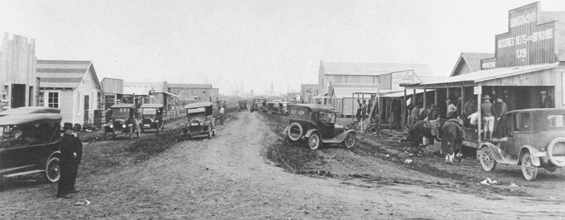Historically Fort Bend:
Blue Ridge

A photo of the Blue Ridge Townsite, probably from the 1920s of Main Street looking east.
by Chris Godbold
A crest of land on Oyster Creek in the northeast part of Fort Bend County lay unoccupied until the 1890s. It was part of Austin’s
Colony. In 1893, W. Allen Robinson and his family moved to Fort Bend County from Arlington, Texas. They settled in the new town of Missouri City. Robinson built his ranch headquarters nearby on the ridge of Oyster Creek. Other families such as the Dew brothers soon followed the Robinsons to the Missouri City area and to Blue Ridge. In the late 1910s, the state of Texas leased over 4,000 acres to create the Blue Ridge State Prison Farm. The ridge remained undeveloped until 1919 when the discovery of oil nearby spawned a search for black gold at Blue Ridge.
Real oil production at Blue Ridge started in 1920 with an explosion of 173,085 barrels of crude oil generated by the field. Soon after, a salt mine also opened. Natural gas was discovered there in 1925. By this time a small boom town alternatively called Hobby, after William P. Hobby, had formed with gambling houses and a bank. These were frequented largely by employees from the prison farm and the oil companies drilling in the area, most notably Gulf Oil. There was no post office or school.
In February 1921, all eyes were drawn to this young town when the Blue Ridge State Bank was robbed and the cashier, Robert L. Kirby, was killed. A feverish investigation ensued and two suspects were arrested three days later. One of them, Fred Absolon, was a given a sensational trial in April of that year at the Fort Bend County Courthouse in Richmond. After a week of motions and testimony, he was found guilty and sentenced to life imprisonment. He died in prison the next year.
Blue Ridge was incorporated by 1936. Most of the residents were prison employees. In 1958, the prison system decided to sell its property at Blue Ridge to developers. There were 50 residents in 1970. In later years, portions of the area were annexed by nearby cities and several developments were built. There is still drilling activity at Blue Ridge today. Not too bad for a crest of land that was originally unoccupied.

A postcard, “Booth No. 1 2,500 Barrels, S. Well, Blue Ridge.”
Bibliography:
A Handbook of Texas Online, Peggy Isbell and Charles Woodson, “Blue Ridge, TX (Fort Bend County),” accessed August 30, 2016, http://www.tshaonline.org/handbook/online/articles/hnb51.
Heard, F. L. “Famous Trial: Blue Ridge Bank Robber and Murderer.” TMs (copy). F. L. Heard Papers, Collection, Fort Bend County Museum Association, Richmond, TX.
McMillan, S. A. The Book of Fort Bend County Texas. 1926.
Wharton, Clarence. History of Fort Bend County. San Antonio: The Naylor Company, 1939. Reprint, Austin: Eakin Press/Sunbelt Media Inc., 2001.
Historical facts and photos courtesy of the Fort Bend County
Museum Association, Richmond, TX









